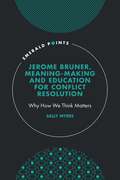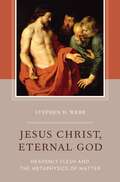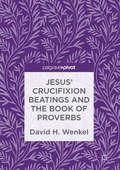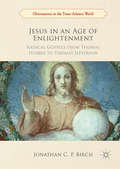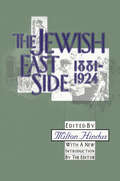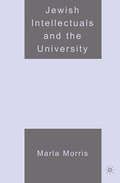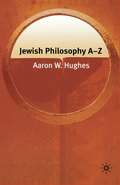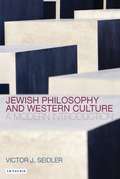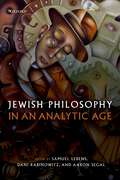- Table View
- List View
Jerome Bruner, Meaning-Making and Education for Conflict Resolution: Why How We Think Matters (Emerald Points)
by Sally MyersThe way we think about things matters just as much as what we think about things.This timely text investigates the work of educational philosopher and psychologist Jerome Bruner through the areas of knowledge representation, meaning-making, education and dispute. What people represent to others might not always be what they actually think. However, accepting this limitation, the aim of this book is to offer a means of examining representations about a given subject and an understanding of how those representations might change over time in response to learning, crisis, and encounter with 'other'.Myers offers an educational intervention that invites development of representations in response to difference. Presenting a new framework for examining controversy between worldviews and a method for creating space for difference, the book brings this into dialogue with education and research, conflict resolution and religion. This framework maps representations and proposes a method of engaging the psychological processes involved in changing representations.An excellent resource of interest to researchers, professionals and postgraduate students alike in education, sociology and philosophy related disciplines.
Jesus Christ, Eternal God: Heavenly Flesh and the Metaphysics of Matter
by Stephen H. WebbIn this groundbreaking study, Stephen H. Webb offers a new theological understanding of the material and spiritual: that, far from being contradictory, they unite in the very stuff of the eternal Jesus Christ. Accepting matter as a perfection (or predicate) of the divine requires a rethinking of the immateriality of God, the doctrine of creation out of nothing, the Chalcedonian formula of the person of Christ, and the analogical nature of religious language. It also requires a careful reconsideration of Augustine's appropriation of the Neo-Platonic understanding of divine incorporeality as well as Origen's rejection of anthropomorphism. Webb locates his position in contrast to evolutionary theories of emergent materialism and the popular idea that the world is God's body. He draws on a little known theological position known as the ''heavenly flesh'' Christology, investigates the many misunderstandings of its origins and relation to the Monophysite movement, and supplements it with retrievals of Duns Scotus, Caspar Scwenckfeld and Eastern Orthodox reflections on the transfiguration. Also included in Webb's study are discussions of classical figures like Barth and Aquinas as well as more recent theological proposals from Bruce McCormack, David Hart, and Colin Gunton. Perhaps most provocatively, the book argues that Mormonism provides the most challenging, urgent, and potentially rewarding source for metaphysical renewal today. Webb's concept of Christian materialism challenges traditional Christian common sense, and aims to show the way to a more metaphysically sound orthodoxy.
Jesus Christ, Eternal God: Heavenly Flesh and the Metaphysics of Matter
by Stephen H. WebbIn this groundbreaking study, Stephen H. Webb offers a new theological understanding of the material and spiritual: that, far from being contradictory, they unite in the very stuff of the eternal Jesus Christ. Accepting matter as a perfection (or predicate) of the divine requires a rethinking of the immateriality of God, the doctrine of creation out of nothing, the Chalcedonian formula of the person of Christ, and the analogical nature of religious language. It also requires a careful reconsideration of Augustine's appropriation of the Neo-Platonic understanding of divine incorporeality as well as Origen's rejection of anthropomorphism. Webb locates his position in contrast to evolutionary theories of emergent materialism and the popular idea that the world is God's body. He draws on a little known theological position known as the ''heavenly flesh'' Christology, investigates the many misunderstandings of its origins and relation to the Monophysite movement, and supplements it with retrievals of Duns Scotus, Caspar Scwenckfeld and Eastern Orthodox reflections on the transfiguration. Also included in Webb's study are discussions of classical figures like Barth and Aquinas as well as more recent theological proposals from Bruce McCormack, David Hart, and Colin Gunton. Perhaps most provocatively, the book argues that Mormonism provides the most challenging, urgent, and potentially rewarding source for metaphysical renewal today. Webb's concept of Christian materialism challenges traditional Christian common sense, and aims to show the way to a more metaphysically sound orthodoxy.
Jesus' Crucifixion Beatings and the Book of Proverbs
by David H. WenkelThis study takes a Christian perspective on the entire Bible, rather than simply the New Testament. David Wenkel asks: Why did Jesus have to be beaten before his death on the cross? Christian theology has largely focused on Jesus’ death but has given relatively little attention to his sufferings. Wenkel’s answer contextualizes Jesus’ crucifixion sufferings as informed by the language of Proverbs. He explains that Jesus’ sufferings demonstrate the wisdom of God’s plan to provide a substitute for foolish sinners. Jesus was beaten as a fool – even though he was no fool, in order to fulfill God’s loving plan of salvation. This analysis is then placed within the larger storyline of the whole bible – from the Garden of Eden to the story of Israel and beyond.
Jesus' Crucifixion Beatings and the Book of Proverbs
by David H. WenkelThis study takes a Christian perspective on the entire Bible, rather than simply the New Testament. David Wenkel asks: Why did Jesus have to be beaten before his death on the cross? Christian theology has largely focused on Jesus’ death but has given relatively little attention to his sufferings. Wenkel’s answer contextualizes Jesus’ crucifixion sufferings as informed by the language of Proverbs. He explains that Jesus’ sufferings demonstrate the wisdom of God’s plan to provide a substitute for foolish sinners. Jesus was beaten as a fool – even though he was no fool, in order to fulfill God’s loving plan of salvation. This analysis is then placed within the larger storyline of the whole bible – from the Garden of Eden to the story of Israel and beyond.
Jesus in an Age of Enlightenment: Radical Gospels from Thomas Hobbes to Thomas Jefferson (Christianities in the Trans-Atlantic World)
by Jonathan C. BirchThis book explores the religious concerns of Enlightenment thinkers from Thomas Hobbes to Thomas Jefferson. Using an innovative method, the study illuminates the intellectual history of the age through interpretations of Jesus between c.1750 and c.1826. The book demonstrates the persistence of theology in modern philosophy and the projects of social reform and amelioration associated with the Enlightenment. At the core of many of these projects was a robust moral-theological realism, sometimes manifest in a natural law ethic, but always associated with Jesus and a commitment to the sovereign goodness of God. This ethical orientation in Enlightenment discourse is found in a range of different metaphysical and political identities (dualist and monist; progressive and radical) which intersect with earlier ‘heretical’ tendencies in Christian thought (Arianism, Pelagianism, and Marcionism). This intellectual matrix helped to produce the discourses of irenic toleration which are a legacy of the Enlightenment at its best.
Jesus überlistet Darwin: Mit einem Vorwort von Thomas Grunwald (TRACE Transmission in Rhetorics, Arts and Cultural Evolution)
by Heiner MühlmannDas Werk bietet eine kompakte, leicht lesbare und verständliche Einführung in die Darwinsche Theorie der Kulturevolution. Dabei wird Kultur nicht als Prozess eines genetisch-biologischen Determinismus beschrieben, sondern als eigengesetzliche Evolution. Für eine spannende Lektüre sorgt das kulturelle Fallbeispiel "Jesus", das den Konflikt Religion/Evolutionstheorie aufgreift. Das Werk ist didaktisch hervorragend aufbereitet, indem Sprache durch Illustrationen und Diagramme optimal ergänzt wird.
Jet Lag (Object Lessons)
by Christopher J. LeeObject Lessons is a series of short, beautifully designed books about the hidden lives of ordinary things. Jet lag is a momentary condition resulting from the human body and its inner clock being pitched against the time-leaping effects of modern aviation. But more than that, it is a situation that explains time, technology, and the human body. Jet lag epitomizes the accelerated world we live in. It makes the speed and discomfort of globalization tangible on a personal level. Tracing physiological, temporal, technological, and cultural meanings, Christopher J. Lee's Jet Lag ponders our intrinsic human limits in the face of modern innovation, revealing the latent costs of global cosmopolitanism today.Object Lessons is published in partnership with an essay series in The Atlantic.
Jet Lag (Object Lessons)
by Christopher J. LeeObject Lessons is a series of short, beautifully designed books about the hidden lives of ordinary things. Jet lag is a momentary condition resulting from the human body and its inner clock being pitched against the time-leaping effects of modern aviation. But more than that, it is a situation that explains time, technology, and the human body. Jet lag epitomizes the accelerated world we live in. It makes the speed and discomfort of globalization tangible on a personal level. Tracing physiological, temporal, technological, and cultural meanings, Christopher J. Lee's Jet Lag ponders our intrinsic human limits in the face of modern innovation, revealing the latent costs of global cosmopolitanism today.Object Lessons is published in partnership with an essay series in The Atlantic.
Jewish Antifascism and the False Promise of Settler Colonialism
by Max KaiserThis book takes a timely look at histories of radical Jewish movements, their modes of Holocaust memorialisation, and their relationships with broader anti-colonial and anti-racist struggles. Its primary focus is Australia, where Jewish antifascism was a major political and cultural force in Jewish communities in the 1940s and early 1950s. This cultural and intellectual history of Jewish antifascism utilises a transnational lens to provide an exploration of a Jewish antifascist ideology that took hold in the middle of the twentieth century across Jewish communities worldwide. It argues that Jewish antifascism offered an alternate path for Jewish politics that was foreclosed by mutually reinforcing ideologies of settler colonialism, both in Palestine and Australia.
Jewish Christians and Christian Jews: From the Renaissance to the Enlightenment (International Archives of the History of Ideas Archives internationales d'histoire des idées #138)
by Gordon M. Weiner Richard H. PopkinThe appearance of religious toleration combined with the intensification of the search for theological truth led to a unique phenomenon in early modern Europe: Jewish Christians and Christian Jews. These essays will demonstrate that the cross-fertilization of these two religions, which for so long had a tradition of hostility towards each other, not only affected developments within the two groups but in many ways foreshadowed the emergence of the Enlightenment and the evolution of modern religious freedom.
Jewish Cryptotheologies of Late Modernity: Philosophical Marranos (Routledge Jewish Studies Series)
by Agata Bielik-RobsonThis book aims to interpret ‘Jewish Philosophy’ in terms of the Marrano phenomenon: as a conscious clinamen of philosophical forms used in order to convey a ‘secret message’ which cannot find an open articulation. The Marrano phenomenon is employed here, in the domain of modern philosophical thought, where an analogous tendency can be seen: the clash of an open idiom and a secret meaning, which transforms both the medium and the message. Focussing on key figures of late modern, twentieth century Jewish thought; Hermann Cohen, Gershom Scholem, Walter Benjamin, Franz Rosenzweig, Theodor Adorno, Ernst Bloch, Jacob Taubes, Emmanuel Levinas and Jacques Derrida, this book demonstrates how their respective manners of conceptualization swerve from the philosophical mainstream along the Marrano ‘secret curve.’ Analysing their unique contribution to the ‘unfinished project of modernity,’ including issues of the future of the Enlightenment, modern nihilism and post-secular negotiation with religious heritage, this book will be essential reading for students and researchers with an interest in Jewish Studies and Philosophy.
Jewish Cryptotheologies of Late Modernity: Philosophical Marranos (Routledge Jewish Studies Series)
by Agata Bielik-RobsonThis book aims to interpret ‘Jewish Philosophy’ in terms of the Marrano phenomenon: as a conscious clinamen of philosophical forms used in order to convey a ‘secret message’ which cannot find an open articulation. The Marrano phenomenon is employed here, in the domain of modern philosophical thought, where an analogous tendency can be seen: the clash of an open idiom and a secret meaning, which transforms both the medium and the message. Focussing on key figures of late modern, twentieth century Jewish thought; Hermann Cohen, Gershom Scholem, Walter Benjamin, Franz Rosenzweig, Theodor Adorno, Ernst Bloch, Jacob Taubes, Emmanuel Levinas and Jacques Derrida, this book demonstrates how their respective manners of conceptualization swerve from the philosophical mainstream along the Marrano ‘secret curve.’ Analysing their unique contribution to the ‘unfinished project of modernity,’ including issues of the future of the Enlightenment, modern nihilism and post-secular negotiation with religious heritage, this book will be essential reading for students and researchers with an interest in Jewish Studies and Philosophy.
The Jewish East Side: 1881-1924 (The Library of Conservative Thought)
by Milton HindusThis book, originally published as The Old East Side, is a collection of literature and documents ranging from the autobiography of the sculptor Jacob Epstein and the novels of Abraham Cahan to the reporting of William Dean Howells and the fictional reconstruction of a vanished world by Henry Roth. The world is that of the old shtetl transplanted to a new, growing country, where "the ghetto" (in the years 1881-1924) was an unstable mixture of nostalgic elements and the pressures of American economic and social reality.The productivity, both intellectual and material, of the section of New York known as the East Side during those forty years around the turn of the twentieth century has become a legend among many Jews in this country and deserves to become better known to many more of other ethnic origins. The lower East Side was paradoxically a wilderness to be traversed and a portion of that "promised land" which had been glimpsed with so much hope from afar. To wonderfully talented and observant children, like Jacob Epstein, the streets there in the 1880s were as filled with excitement as those of the Arabian Nights. To serious philosophic young men like Morris Raphael Cohen, they were as challenging as the marketplace of Athens had once been to Socrates to achieve intellectual enlightenment and the improvement of the social order.The conditions of abominable crowding and poverty described in the sociological tracts of Jacob Riis, Lillian Wald, and others are better known perhaps to the average reader than the accounts of such pleasures as the dancing schools, the Yiddish theaters, the cafes, the lectures, the literary ferment and activities, described in the pages of Abraham Cahan and Hutchins Hapgood. But all the views presented in The Jewish East Side, both dark and bright, are recognizably parts of the same picture. This book will be of value to sociologists, historians, researchers specializing in Judaic studies, and students of literature.
The Jewish East Side: 1881-1924 (The Library of Conservative Thought)
by Milton HindusThis book, originally published as The Old East Side, is a collection of literature and documents ranging from the autobiography of the sculptor Jacob Epstein and the novels of Abraham Cahan to the reporting of William Dean Howells and the fictional reconstruction of a vanished world by Henry Roth. The world is that of the old shtetl transplanted to a new, growing country, where "the ghetto" (in the years 1881-1924) was an unstable mixture of nostalgic elements and the pressures of American economic and social reality.The productivity, both intellectual and material, of the section of New York known as the East Side during those forty years around the turn of the twentieth century has become a legend among many Jews in this country and deserves to become better known to many more of other ethnic origins. The lower East Side was paradoxically a wilderness to be traversed and a portion of that "promised land" which had been glimpsed with so much hope from afar. To wonderfully talented and observant children, like Jacob Epstein, the streets there in the 1880s were as filled with excitement as those of the Arabian Nights. To serious philosophic young men like Morris Raphael Cohen, they were as challenging as the marketplace of Athens had once been to Socrates to achieve intellectual enlightenment and the improvement of the social order.The conditions of abominable crowding and poverty described in the sociological tracts of Jacob Riis, Lillian Wald, and others are better known perhaps to the average reader than the accounts of such pleasures as the dancing schools, the Yiddish theaters, the cafes, the lectures, the literary ferment and activities, described in the pages of Abraham Cahan and Hutchins Hapgood. But all the views presented in The Jewish East Side, both dark and bright, are recognizably parts of the same picture. This book will be of value to sociologists, historians, researchers specializing in Judaic studies, and students of literature.
Jewish Intellectuals and the University
by M. MorrisMarla Morris explores Jewish intellectuals in society and in the university using psychoanalytic theory. Morris examines Otherness as experienced by Jewish intellectuals who grapple with anti-Semitism within the halls of academia. She claims that academia breeds uncertainty and chaos.
Jewish Intelligentsia and Russian Marxism: A Sociological Study of Intellectual Radicalism and Ideological Divergence
by Robert J. BrymJewish-Israeli National Identity and Dissidence: The Contradictions of Zionism and Resistance
by K. AttwellA critical examination of Zionism and its internal resistance by Israeli Jews, this book employs a unique perspective on Israel/Palestine by eschewing presenting identities as concrete and, rather, examining their creation through discourse.
Jewish Law Annual (Jewish Law Annual #10)
by Bernard S JacksonFirst Published in 1992. This collection of papers is Volume ten from The Jewish Law Institute. Split onto three parts, it covers the area of Parent and Child, including amongst others, offences punishable by death, child custody, Parents and Children under Moslem Law, Physical Violence and Herod’s Domestic Court. . Part two entitled Chronicle, has examples of cases and Part three includes a survey of recent literature.
Jewish Law Annual (Jewish Law Annual #10)
by Bernard S JacksonFirst Published in 1992. This collection of papers is Volume ten from The Jewish Law Institute. Split onto three parts, it covers the area of Parent and Child, including amongst others, offences punishable by death, child custody, Parents and Children under Moslem Law, Physical Violence and Herod’s Domestic Court. . Part two entitled Chronicle, has examples of cases and Part three includes a survey of recent literature.
Jewish Materialism: The Intellectual Revolution of the 1870s
by Eliyahu SternA paradigm-shifting account of the modern Jewish experience, from one of the most creative young historians of his generationTo understand the organizing framework of modern Judaism, Eliyahu Stern believes that we should look deeper and farther than the Holocaust, the establishment of the State of Israel, and the influence and affluence of American Jewry. Against the revolutionary backdrop of mid-nineteenth-century Europe, Stern unearths the path that led a group of rabbis, scientists, communal leaders, and political upstarts to reconstruct the core tenets of Judaism and join the vanguard of twentieth-century revolutionary politics. In the face of dire poverty and rampant anti-Semitism, they mobilized Judaism for projects directed at ensuring the fair and equal distribution of resources in society. Their program drew as much from the universalism of Karl Marx and Charles Darwin as from the messianism and utopianism of biblical and Kabbalistic works. Once described as a religion consisting of rituals, reason, and rabbinics, Judaism was now also rooted in land, labor, and bodies. Exhaustively researched, this original, revisionist account challenges our standard narratives of nationalism, secularization, and de-Judaization.
Jewish Philosophy A-Z (Philosophy A-Z)
by NA NAIn an accessible style and format, Jewish Philosophy A-Z covers everything from Philo to Levinas and explores non-Jewish thinkers, such as Plotinus and Heidegger, who have had an important influence on Jewish philosophy.
Jewish Philosophy and Western Culture: A Modern Introduction
by Victor J. SeidlerThis is one of the first textbooks to try to set the entire discipline of Jewish philosophy in its proper cultural, historical and spiritual contexts. In so doing, it introduces the vibrant Jewish philosophical tradition to students while also making a significant contribution to inter-religious dialogue. Victor J Seidler argues that the dominant Platonic tradition in the West has led to a form of cultural ethics which asserts false superiority in its relationships with others. He offers a critical reappraisal of the philosophical underpinnings of this western Christian culture which for so long has viewed Judaism with hostility. Examining the work of seminal Jewish thinkers such as Philo, Buber, Mendelsohn, Herman Cohen, Leo Baeck, Levinas, Rosenzweig and others, the author argues for a code of ethics which prioritises particular and personal moral responsibility rather than the impersonal and universal emphases of the Greek tradition. His provocative and original overview of Jewish philosophy uncovers a vital and neglected tradition of thought which transforms our whole philosophical understanding, and which - properly appreciated - works against the likelihood of a Holocaust recurring.
Jewish Philosophy in an Analytic Age
by Aaron Segal Samuel Lebens Dani RabinowitzSince the classical period, Jewish scholars have drawn on developments in philosophy to enrich our understanding of Judaism. This methodology reached its pinnacle in the medieval period with figures like Maimonides and continued into the modern period with the likes of Rosenzweig. The explosion of Anglo-American/analytic philosophy in the twentieth century means that there is now a host of material, largely unexplored by Jewish philosophy, with which to explore, analyze, and develop the Jewish tradition. Jewish Philosophy in an Analytic Age features contributions from leading scholars in the field which investigate Jewish texts, traditions, and/or thinkers, in order to showcase what Jewish philosophy can be in an analytic age. United by the new and engaging style of philosophy, the collection explores rabbinic and Talmudic philosophy; Maimonidean philosophy; philosophical theology; and ethics and value theory.
Jewish Philosophy in an Analytic Age
Since the classical period, Jewish scholars have drawn on developments in philosophy to enrich our understanding of Judaism. This methodology reached its pinnacle in the medieval period with figures like Maimonides and continued into the modern period with the likes of Rosenzweig. The explosion of Anglo-American/analytic philosophy in the twentieth century means that there is now a host of material, largely unexplored by Jewish philosophy, with which to explore, analyze, and develop the Jewish tradition. Jewish Philosophy in an Analytic Age features contributions from leading scholars in the field which investigate Jewish texts, traditions, and/or thinkers, in order to showcase what Jewish philosophy can be in an analytic age. United by the new and engaging style of philosophy, the collection explores rabbinic and Talmudic philosophy; Maimonidean philosophy; philosophical theology; and ethics and value theory.
